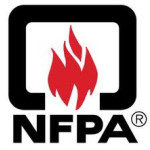- 産業: Fire safety
- Number of terms: 98780
- Number of blossaries: 0
- Company Profile:
Established in 1896, NFPA's mission is to reduce the worldwide burden of fire and other hazards on the quality of life by providing and advocating consensus codes and standards, research, training, and education.
The ratio of the Ctproduct for a gaseous toxicant produced in a given test to that Ctproduct of the toxicant that has been statistically determined from independent experimental data to produce lethality in 50 percent of test animals within a specified exposure and postexposure time.
Industry:Fire safety
The process of transferring air from one SCBA cylinder to another SCBA cylinder of the same rated pressure capacity by connecting them together with properly designed fittings and a high-pressure transfer line.
Industry:Fire safety
The prospective symmetrical fault current at a nominal voltage to which an apparatus or system is able to be connected without sustaining damage exceeding defined acceptance criteria.
Industry:Fire safety
The minimum fluidized bed temperature at which the main fuel can be introduced with resulting stable combustion.
Industry:Fire safety
The preferred SI unit of heat, energy, or work. A joule is the heat produced when one ampere is passed through a resistance of one ohm for one second, or it is the work required to have a distance of one meter against a force of one newton. There are 4. 184 joules in a calorie, and 1055 joules in a British thermal unit (Btu). A watt is a joule/second.
Industry:Fire safety
The pressure vessel or vessels that are an integral part of the SCBA and that contain the breathing gas supply; can be configured as a single cylinder or other pressure vessel, or as multiple cylinders or pressure vessels.
Industry:Fire safety
The rate of water discharged by an automatic sprinkler expressed in gpm (mm/min).
Industry:Fire safety
The process used to inactivate virtually all recognized pathogenic microorganisms but not necessarily all microbial forms, such as bacterial endospore.
Industry:Fire safety
The reconfiguration of a space that affects an exit or a corridor shared by more than one occupant space; or the reconfiguration of a space such that the rehabilitation work area is not permitted to be occupied because existing means of egress and fire protection systems, or their equivalent, are not in place or continuously maintained.
Industry:Fire safety
